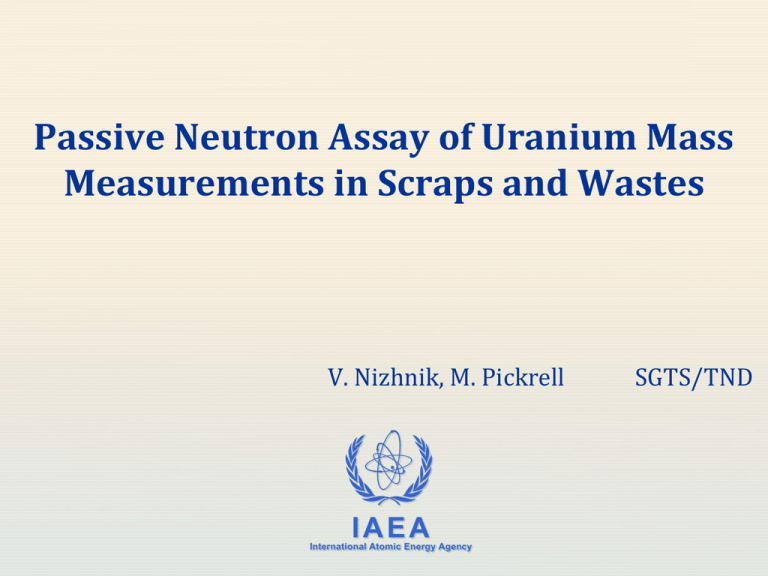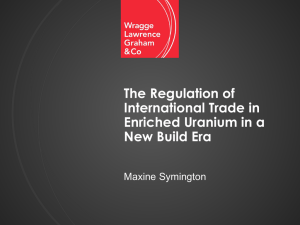Passive Neutron Assay of Uranium Mass Measurement in Scrap and
advertisement

Passive Neutron Assay of Uranium Mass Measurements in Scraps and Wastes V. Nizhnik, M. Pickrell IAEA International Atomic Energy Agency SGTS/TND Conventional Passive Multiplicity • Passive multiplicity is based on a theoretical hierarchy called the Point Model • So named, because it is a zero dimensional. • Therefore, spontaneous fission, multiplication, and alpha-n production are UNIFORM across the sample. • Therefore, the sample nuclear material is evenly distributed in a homogenous matrix. IAEA The Modification Necessary to Measure Uranium Wastes • What happens when the material is not uniform and evenly distributed? • The conventional method develops a bias error. • This work developed a modification of the Point Model / Passive Multiplicity equations to analyze non-uniform, inhomogeneous samples. • Applied to uranium wastes with metal ingots mixed with diffuse oxide powder. IAEA Passive Multiplicity (PM) Assumptions Kill this slide • Homogeneous distribution of nuclear material through an item matrix material • The same chemical form of Uranium material in the item, i.e. uniform (a,n)-neutron production rate in the item volume • Uniform physical property of uranium material (mostly concerns material density) • If item properties are in compliance with listed statement: • all the neutrons are equal in the term of multiplication • Alpha parameter is the same for any point of item material Then Passive Multiplicity Analysis can be applied for precise U mass analysis IAEA Wastes: “Close Look” Example Uranium Metal Production Process Ideal Case UF4 + 2 Mg Umetal + 2 MgF2 In reality UF4 + 2 Mg Product: Single U metal piece and burnt matrix material; both of known mass X·Uchunks + Y·UF4 + Z·MgF2 + W·Mg Product: Number of U metal chunks, unburnt UF4 in un-burnt Mg+MgF2 matrix. Their mas ratios are unknown. Impact on Neutron Multiplicity: • • • • • Non-homogeneous distribution of U material Multi-component chemical composition Unknown mass ratio for uranium material components Non-uniform (a,n)-neutron production rate Spatial dependent neutron multiplication IAEA Passive Multiplicity Conventional Passive Multiplicity Equations Long Crocs Modified Passive Multiplicity Assumptions and known parameters: Assign: x –U metal fraction in total U mass in item Then: (1-x) – fraction of UF4 in total U mass in item U metal chunks are pure: no (a,n)-neutrons production (a = 0) Dispersed un-burnt UF4 material in Mg+MgF2 matrix is nonmultiplying media due to low density (M = 1) Alpha value for UF4 is known, based on U isotopic information IAEA Modified Passive Multiplicity U metal term M– x– mU – UF4 term multiplication in the metal chunks U metal fraction in total U mass in item total U mass in measured item • Corrects for non-uniform distribution of multi-component Uranium material • Determines total Uranium mass in measured item • Determines U mass in metal and UF4 form • Determines neutron Multiplication in metal phase (gives information on average metal chunks size) IAEA Example of U Waste Measurements Plutonium Scrap Multiplicity Counter Counter: • Efficiency 55%: allows fast acquisition of neutron multiplicity data with good statistics • Size of the measurement cavity: d=20cm, h=42cm Items: • 34 Uranium waste items with various Gross Weight (up-to 30kg) • Packed in Poly bags to fit in the measurement cavity IAEA Target total uncertainty: • Not more than 2.3% for 1 Sigma confidential interval Rejection of Cosmic Rays Bursts Cosmic rays prompt neutron “bursts” when interacting with High-Z (Uranium) material nuclei; they produce high multiplicities of detected neutron and affect counting rates. Cycle-by-Cycle Multiplicity Distribution Good Cycle Rejected by RSD based rejection logic 35 30 25 20 Bad Cycle 15 10 5 Good Cycle 0 1 IAEA 11 21 31 Rejected by Multiplicity Distribution analysis logic 41 51 61 71 81 Analysis with Modified PM Conventional vs Modified Method Results Measurement of a batch of uranium waste items (individual item U mass and Total U mass) Theoretical bias of Conventional vs Modified PM for NU U metal average multiplication: M=1.05 Relative UF4 Alpha value a=3.85 content of UF4(1-x) Bias of Total U mass in the measured batch Theoretical Bias The bias is higher in case of analysis of enriched Uranium since values of Multiplication in metal phase and Alpha in UF4 phase are higher then for natural Uranium IAEA




![Olli Heinonen`s technical presentation [PPT].](http://s2.studylib.net/store/data/005572080_1-b7e6fdb5a9b814ad694589987ab2c05e-300x300.png)


